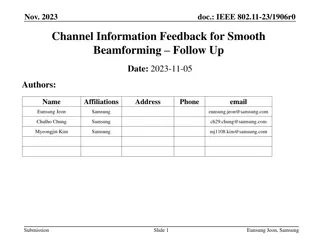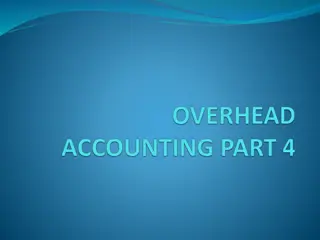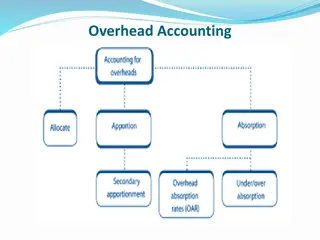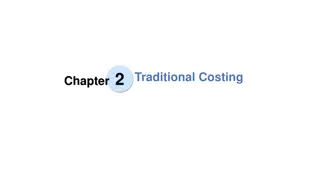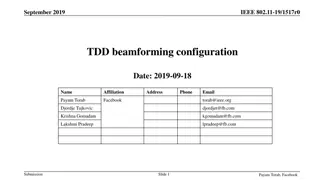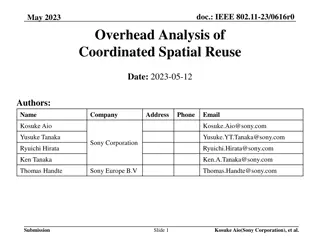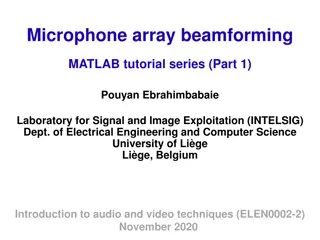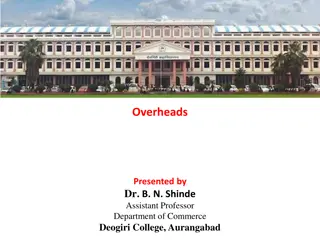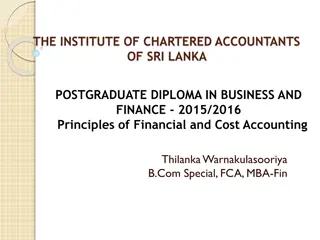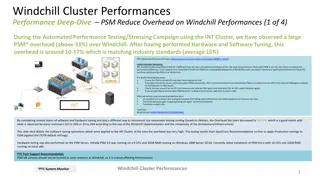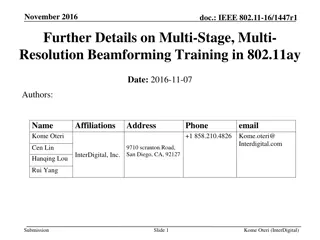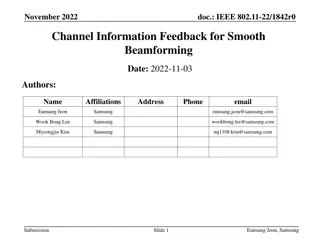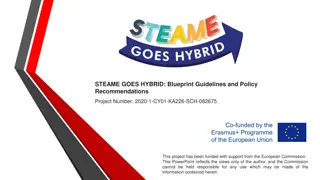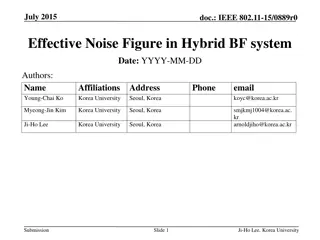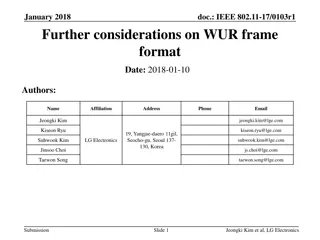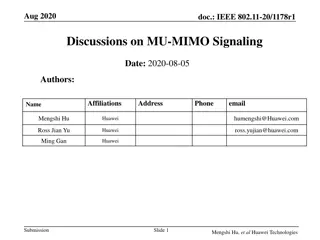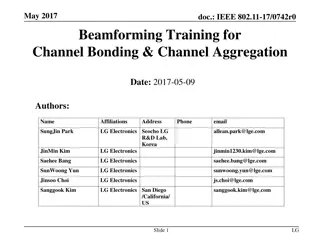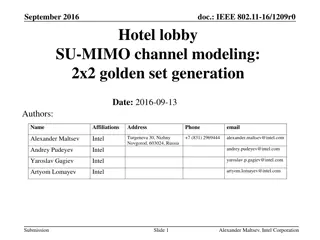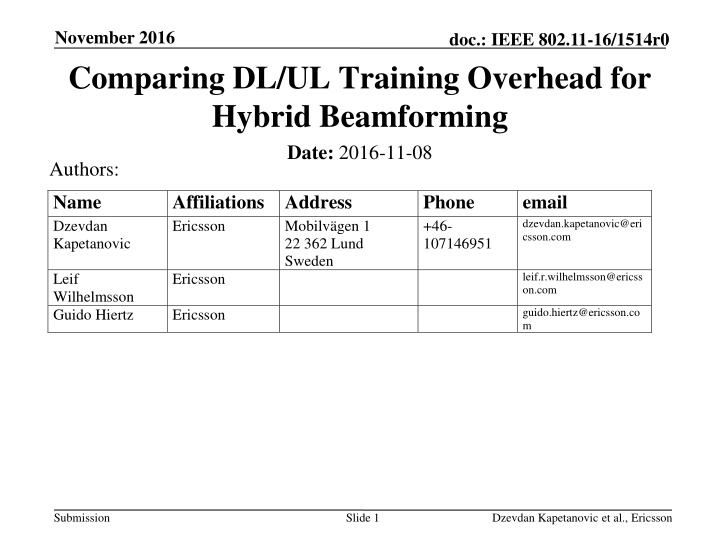
Comparing DL/UL Training Overhead for Hybrid Beamforming in IEEE 802.11-16
Explore the comparison of Downlink (DL) and Uplink (UL) training overhead for Hybrid Beamforming in IEEE 802.11-16 standard, focusing on DL MU-MIMO operations and the effectiveness of explicit DL training versus UL training with massive arrays. The document delves into assumptions related to RF chains, transmit/receive beam codebooks, the size of antennas, and codebooks for APs and STAs. Detailed descriptions of DL and UL training procedures are provided to gain insights on channel information acquisition, precoding, and beamforming strategies for improved wireless communication performance.
Download Presentation

Please find below an Image/Link to download the presentation.
The content on the website is provided AS IS for your information and personal use only. It may not be sold, licensed, or shared on other websites without obtaining consent from the author. If you encounter any issues during the download, it is possible that the publisher has removed the file from their server.
You are allowed to download the files provided on this website for personal or commercial use, subject to the condition that they are used lawfully. All files are the property of their respective owners.
The content on the website is provided AS IS for your information and personal use only. It may not be sold, licensed, or shared on other websites without obtaining consent from the author.
E N D
Presentation Transcript
November 2016 Comparing DL/UL Training Overhead for Hybrid Beamforming Date: 2016-11-08 Authors: doc.: IEEE 802.11-16/1514r0 Name Dzevdan Kapetanovic Affiliations Address Ericsson Phone +46- 107146951 email dzevdan.kapetanovic@eri csson.com Mobilv gen 1 22 362 Lund Sweden leif.r.wilhelmsson@ericss on.com Leif Wilhelmsson Guido Hiertz Ericsson guido.hiertz@ericsson.co m Ericsson Submission Slide 1 Dzevdan Kapetanovic et al., Ericsson
November 2016 doc.: IEEE 802.11-16/1514r0 Introduction DL MU-MIMO is included in 11ay An essential part of DL MU-MIMO operation is the obtaining of channel information for proper precoding With massive arrays in 11ay, it is unclear if explicit training (DL training) is always to prefer, or if sometimes UL training could be more effective Submission Slide 2 Dzevdan Kapetanovic et al., Ericsson
November 2016 doc.: IEEE 802.11-16/1514r0 Assumptions ?? RF chains, transmit beam codebook ?? AP has ??? antennas, ??? ??? ?? and receive beam codebook ??? ??? RF chains, transmit beam STA ? has ???? antennas, ??? codebook ??? The receive (and transmit) codebooks are beams mapping antenna elements to RF chains (and vice versa) ???? and receive beam codebook ??? ???? STA codebooks have same size |??? |??? ???1| = = ??? ???1| = = ??? ????= |??? ????= |??? ???| ???| Submission Slide 3 Dzevdan Kapetanovic et al., Ericsson
November 2016 doc.: IEEE 802.11-16/1514r0 DL Training ???, ,???? ??? ???= ???,1 ???,???,2 ??? ??? Transmitted in different time slots ???1= ???,1 ???1,???,2 ???1, ,???, ??? ? ???1 ???1 ???,?1 STA1 ?1= ??1 ?? ???1 ???,???? ??? ?? ??,???,2 ??, ,???, ??? ?1 ?2 ?3 ???,1 ?? ???2= ???,1 ???2,???,2 ???2, ,???, ??? ? ???2 AP ? = ??? ??? ???2 ???,?1 STA2 ?2= ??2 ???2 ???,???? ?? ??= ???,1 ??,???,2 ??, ,???, ??? ??? ???2 ?? ???3= ???,1 ???3,???,2 ???3, ,???, ??? ???3 ??? ??? ? ???3 ???,?1 STA3 ?3= ??3 ???3 ???,???? ??? Submission Slide 4 Dzevdan Kapetanovic et al., Ericsson
November 2016 doc.: IEEE 802.11-16/1514r0 UL Training ???, ,???? ??? ???= ???,1 ???,???,2 ??? ??? ???1= ???,1 ???1,???,2 ???1, ,???, ??? ???1 STA1 ? ?? ???,?1 ?? ?1 ?2 ?3 ? ? = ?? ?? ???,???? ?? ??= ? ???2= ???,1 ???2,???,2 ???2, ,???, ??? ???2 ??? AP ??? ? ?? ??= ???,1 ??,???,2 ??, ,???, ??? STA2 ??? ?? ???3= ???,1 ???3,???,2 ???3, ,???, ??? ???3 ??? ??? STA3 Submission Slide 5 Dzevdan Kapetanovic et al., Ericsson
November 2016 doc.: IEEE 802.11-16/1514r0 DL Training Overhead To learn the projections of the AP transmit codebook and STA receive codebook on the physical channel AP transmits all beams takes |??? STA can listen to ??? ??? ??| time slots ??? beams simultaneously takes ??? ???/ ????? ??? time slots to obtain all projections After STAs obtain all projections, each STA feeds back some information about the channel Feedback overhead depends on channel information content and PHY modulation (SC or OFDM) Let ?? denote the time slot duration of a feedback packet ????? ??? ??? ??? Total number of time slots: + ??? + additional overhead ??? (discarded) Submission Slide 6 Dzevdan Kapetanovic et al., Ericsson
November 2016 doc.: IEEE 802.11-16/1514r0 UL Training Overhead To learn the projections of the AP receive codebook and STA transmit codebook on the physical channel Each STA transmits its beams takes ?|??? AP can listen to ??? ? ??? No feedback needed here Total number of time slots: ? ??? ???| time slots ?? beams simultaneously takes ?? time slots to obtain all projections ?????? ??/??? ?????? ??/??? ?? Submission Slide 7 Dzevdan Kapetanovic et al., Ericsson
November 2016 doc.: IEEE 802.11-16/1514r0 DL/UL Overhead Comparison ??? ????? ??? ?????? ??? DL training: ??? + ??? time slots ??? ?? UL training: ? ??? time slots ?? ?? ??? ???? ???+??? ????? ???? ??? ??? DL training / UL training = ?????? ?? ??? In order to have same beam accuracy in UL and DL, ??? ??= ??? ??= ???, ??? ???= ??? ???= ???? ?? ??????????+??? ??? ???? ???? ???? ?? ??? + ??? ??????? ??? ???? DL training / UL training = = ??????? Submission Slide 8 Dzevdan Kapetanovic et al., Ericsson
November 2016 doc.: IEEE 802.11-16/1514r0 DL/UL Overhead Comparison ???? ?? ??? + ??? ??????? ??? ???? DL training / UL training = ???< ??? ??, DL training overhead is Clearly, if ???? always larger Independent of the feedback packet duration ??, the larger the DL In general, the larger the ??? training overhead In cellular, it is expected that ??? overhead very large ?? ??? ???, which makes the Submission Slide 9 Dzevdan Kapetanovic et al., Ericsson
November 2016 doc.: IEEE 802.11-16/1514r0 Example: Full Channel Overhead Assume that the AP wants to obtain the full ????? ???channel matrix ? This implies that For DL training: ??? For UL training: ??? ??= ???, ??? ??= ???, ??? ???= ???? ???= ???? DL training overhead / UL training overhead = ??? ???? ???? ?? ??? ??????? + ??? Submission Slide 10 Dzevdan Kapetanovic et al., Ericsson
November 2016 doc.: IEEE 802.11-16/1514r0 Example: Full Channel Overhead ???= 1 [1] In some applications, it is expected that ??? Moreover, ??? beamforming performance [1] Hence, an AP with 128 antennas and 8 RF chains, and 4 STAs with 4 antennas and 1 RF chain each, sounds as a reasonable scenario for 11ay ?? 2? results in (almost) full digital Above numbers give that UL training takes ???????? = ?? ??? 256 time slots ?? 64 times longer than UL training DL training takes 2 + Submission Slide 11 Dzevdan Kapetanovic et al., Ericsson
November 2016 doc.: IEEE 802.11-16/1514r0 UL Training Issues If UL pilot power is low (is it?), estimation quality at AP decreases In 60 GHz, due to directivity, the estimation quality is increased by spatial filtering In OFDM systems, filtering across frequency increases estimation quality Another remedy is to increase training duration => UL training overhead = ??? ??? ??? ?? is a multiplicative constant that increases training duration DL/UL training overhead ratio reduced by ?? Calibration issue is well known (as well as its remedies) ?????? ?? ?? Submission Slide 12 Dzevdan Kapetanovic et al., Ericsson
November 2016 doc.: IEEE 802.11-16/1514r0 DL Training Pros & Cons DL Training Pros: Transparent to DL-UL channel reciprocity Cons Training overhead can be large (for good channel knowledge) -> outdated CSI Requires quantization and feedback from STA Submission Slide 13 Dzevdan Kapetanovic et al., Ericsson
November 2016 doc.: IEEE 802.11-16/1514r0 UL Training Pros & Cons UL Training Pros Can substantially reduce training overhead compared to DL training No channel quantization and feedback from STAs If calibrated, same performance can be achieved as with DL training (let UL codebooks = DL codebooks) Cons Pilot power issue? Imperfections (if not calibrated) can decrease performance (UL codebooks != DL codebooks) Submission Slide 14 Dzevdan Kapetanovic et al., Ericsson
November 2016 doc.: IEEE 802.11-16/1514r0 References [1] A. Molisch et al., Hybrid Beamforming for Massive MIMO A Survey , available on ArXiv. Submission Slide 15 Dzevdan Kapetanovic et al., Ericsson
November 2016 doc.: IEEE 802.11-16/1514r0 Straw Poll Do you believe UL training for DL MU-MIMO shall be included as an optional feature in the 802.11ay SFD? Yes No More information needed No opinion: Submission Slide 16 Dzevdan Kapetanovic et al., Ericsson
November 2016 doc.: IEEE 802.11-16/1514r0 Straw Poll For those who voted more information needed What type of information do you request? Simulation results Extended theoretical background Motivation for the feature Submission Slide 17 Dzevdan Kapetanovic et al., Ericsson

